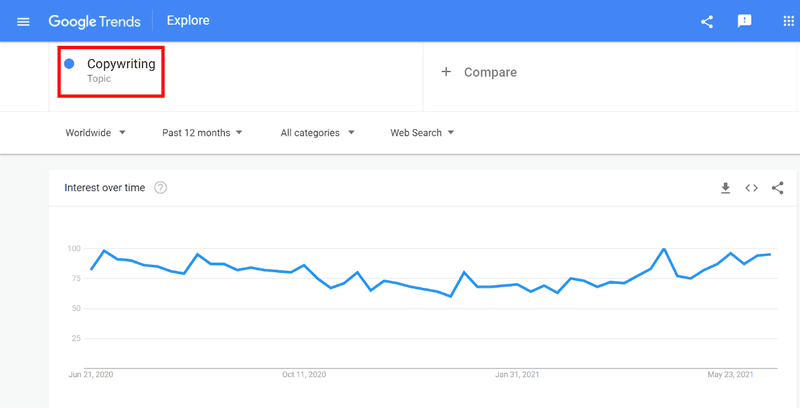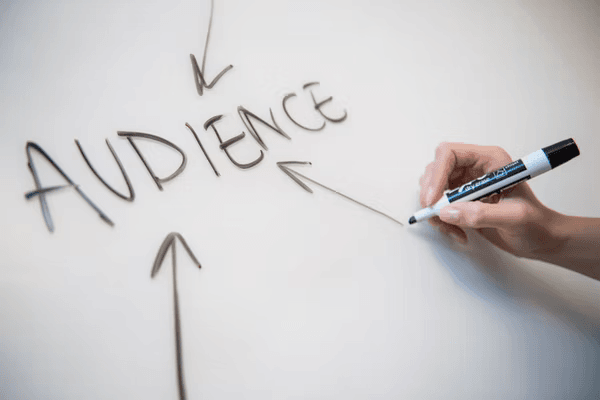
Copywriting has emerged as one of the most in-demand skills for the year 2021. With copywriting jobs paying up to $100,000 per year, the demand will continue to rise in the coming years.
Why? Every company can profit from the skills of a talented copywriter. Copywriting can help or hinder a company's success, from startup companies to Fortune 500s.
The fun fact is that anyone can become a copywriter quite easily. To finesse this skill, you do not need a degree or specialized training.
So, whether you want to start a career as a freelance copywriter or simply enhance the content for your own business, this guide will provide you with a step-by-step plan for getting started with copywriting.
What Is Copywriting?
The practice of crafting written content to inform, inspire, or influence is known as copywriting. Copywriting is typically used to increase sales and conversions. Examples of copywriting are everywhere – Sales letters, blog posts, ads, social media posts, you name it.
However, copywriting entails much more than just words. Great copy offers a fascinating story while also representing your company's image. It pulls the trigger for anyone reading what you wrote, compelling them to make a decision or take action.
Copywriting does not sell items or services; rather, it sells emotions.
According to Google Trends, the global interest in copywriting is very high, based on the search results in the last 12 months.

This is why mastering copywriting skills is so important now!
Benefits of Mastering The Art of Copywriting
Here are some of the advantages of getting proficient at copywriting:
- Increase conversion rates on important pages
- Improve article structure and flow
- Increase the number of people who engage with your social media posts
- Increase the number of individuals who share your content
- Recognize your customer's wants and needs
In other words, copywriting may help you improve almost every aspect of your marketing efforts.
What Does A Copywriter Do?
A copywriter, obviously, spends most of his or her day writing. However, a copywriter's job entails more than just placing words after words.
In reality, skilled copywriters devote significant time to understanding their clients and audience. They try to learn how the product they're writing about may benefit their prospects.
If you're creating copy about your own product or service, you're probably already familiar with what it is, how it operates, and how it compares to the competitors.
You need to find out what your audience's emotions, fears, and desires are, and how they express themselves. You should be able to write copy that speaks directly to them.
How To Become A Copywriter?
To become a copywriter, you don't need any official training or education. Instead, you should practice the following 7 skills:
- Customer research and understanding
- Grammar and sentence structure
- Website copywriting
- Grammatical and spelling errors
- Persuasion
- Structure of the content
- Online marketing
To be clear, it takes time to become a skilled copywriter. However, it is a marketing skill that you may use to gain clients as a freelance copywriter or to expand your network.
But what makes a great copy?
10 Elements of Great Copywriting
Obviously, you should practice the 7 skills mentioned above. But to finesse a copy and take it to the next level, you should keep in mind the following 10 elements. Anyone can benefit from these elements as these elements are articulated for a beginner.

1. Grammatical Knowledge and Soundness
Being grammatically sound is a prerequisite to becoming a good copywriter. If your writing has spelling or grammar issues, it may jeopardize your ultimate purpose.
People have a negative perception of a brand, product, or service when they discover errors in copy, especially short-form copy.
No one is flawless. When you write a lot of words every week, you will make plenty of errors. However, one or two grammar errors buried in a 3,000-word blog piece can be overlooked.
But a spelling mistake on a homepage or sales email is far more serious.
Avoid the impulse to rush through this process. Edit your text with a text editor and use proofreading tools. Read it aloud. Before you post it, double-check everything.
2. Power of Persuasion
Persuasive copy is effective. You must write in such a way that someone is compelled to take an action.
Why should customers purchase your products? What are the benefits of subscribing to your email newsletter?
You're not selling smartwatches, but rather luxury. You're not selling insurance, but rather protection. Determine the emotions you want to evoke from the reader and choose the best combination of words to elicit those feelings.
3. Avoid Jargons
While writing for a broad audience, remove any industry-specific phrases from your copy.
If you're a lawyer, someone who hasn't studied the law should be able to grasp what you're saying. If you're a doctor, make sure your copy is understandable to people who aren't health practitioners.
You should also avoid slang and acronyms at all costs. Slang is frequently perceived as unprofessional (unless it is part of your brand image), and you can't assume that everyone knows the acronyms you're using.
Great copywriters can take a complex subject and convey it in words that even a fifth-grader can grasp.
4. A Compelling Call-To-Action (CTA)
Simply presenting your brand, products, services, or company mission is still only half of the equation. You must also provide your audience with a clear call to action.
What is your copy's ultimate goal?
It should be obvious to anybody reading it.
Make sure the message has been conveyed if you want people to buy something or engage with you. Consumers should not be kept in the dark on what to do. Create CTAs that encourage conversions.
5. Search Engine Optimization
Optimizing your copy for SEO is exclusive to web copy.
The goal of SEO is to ensure that your content shows up when someone is searching for it. Use keywords that will help your pages rank high in Search Engine Results Pages (SERPs).

Keywords are only one of several elements that contribute to high-ranking content. While SEO-friendly copy is vital, it will not necessarily make or break your website. So, if it affects the quality of your writing, don't push keywords.
You can use any software to get help, especially if you’re a beginner. Be it keyword tracking or link building, BacklinkSEO got you covered.
6. Direct and Straight To The Point
A great copy is concise and to the point. You must be able to deliver your message in the fewest number of words possible. Avoid “fluff” or “filler” phrases and use short sentences and paragraphs.
Learn to write catchy copy. Long sentences make it simple for the reader to become distracted or lost.
We have explored the significance of writing error-free copy earlier. If you're being direct, there are several exceptions to grammatical rules. To show a point, you may write three one-word statements in a row. This is where a copy differs from articles.
7. Enthralling Lead
The best copy starts with an eye-catching lead. You must find a technique to attract readers' attention – whether through a heading, subheading, subject line, or introductory line.
You can use action words to draw the attention of your readers. You can start with a statistic, number, or compelling fact.
According to an ancient copywriting adage, a headline aims to encourage someone to read your opening sentence. Your first line's objective is to entice them to read your second line, and so on.
If your lead fails to attract your readers, the rest of your content is destined to fail.
8. Channel-Specific Copy
Every piece of copy you write cannot be repurposed or reused across all marketing channels. Landing pages and billboards should have different copies. Email copies should be written differently than any social media post.
Even if you're advertising the same product or promotion, you must write differently for each distribution channel.
Tone, quantity, style, and execution are just a few examples of variables to consider depending on the channel. In general, text prolongs as one progresses down the sales funnel.
While this is not a hard and fast rule, it does apply in most cases. For instance, the copy in a brand awareness billboard will be no more than a few words long.
The copy on your internal landing page will be longer than that on your homepage. Product pages would be more detailed than landing pages.
The tonality of email copy will differ from that of product pages and landing pages.
So don't just generate a copy without considering how that will be received. Always be aware of the distribution channel for which you are writing and make adjustments accordingly.
9. Knowing The Audience
In addition to the distribution strategy, you must know who will be reading your text.
A client visiting your homepage may be unfamiliar with your brand, whereas an email subscriber is already aware of who you are. As a result, you won't have to reintroduce yourself and offer your brand narrative in every email campaign. That is a waste of valuable content, and the repetitive nature will soon lose your reader's attention.

Instead, create copies that are appealing to your target audience. Don't strive to please everyone.
A company that sells inflatables and toy cars do not have the same audience as a company that provides enterprise SaaS. Recognize the difference and adapt accordingly.
10. Comprehensive Understanding of the Offer
Novice copywriters frequently make the mistake of jumping right into the writing process. However, you should not begin writing until you have a strong understanding of the product, service, brand, or offer.
Assume you are a freelancer who a company contracts to generate landing page copy. Based on the complexity of the offering, it may take you hours or even days before you contemplate writing anything.
It is impossible to deliver a message to an audience if you do not have a good knowledge of the offer yourself.
5 Copywriting Formulas
If you're a beginner at copywriting, you can use many methods to help you get started. Consider these copywriting techniques to be a handy template or cheat sheet.
1. The FAB Formula
This is one of the most fundamental copywriting tactics you can use. Instead of simply describing a product or service features, discover ways to showcase the end results and takeaways that the user will receive.
Here’s what FAB actually means:
- Features – What do you have to offer?
- Advantages – How does it help to solve an issue or improve things?
- Benefits – What does the reader get as a result of this?
The FAB formula is ideal for product or service-related copy.
2. The BAB Formula
BAB formula is good for narrating stories. It is intended to identify the reader's pain points.
Here’s what BAB means:
- Before – This is your current situation.
- After – This is how you will feel once the situation has been resolved.
- Bridge – This is how you'll get there.
3. The Four U's Formula
Four U’s consist of Useful, Urgency, Unique, and Ultra-specific.
- Useful – How can you assist the reader?
- Urgency – Instill a sense of urgency.
- Unique – Explain why the benefits cannot be found elsewhere.
- Ultra-specific – Don't be vague. Be specific.
The 4 U's formula is effective for commercials and social media copy. Create a sense of urgency, such as FOMO, as an emotional trigger that drives the reader to act swiftly.
4. The Oath Formula
The OATH formula pushes you to produce an audience-specific copy. It can assist you in creating one-of-a-kind copy depending on the reader's market awareness of your brand, product, or service.
- Oblivious – The reader has no idea what your brand or proposition is about.
- Apathetic – They are aware of your presence yet are uninterested or indifferent to it.
- Thinking – The reader has spotted a possible need.
- Hurting – They are in pain because they have a problem that needs to be treated right away.
As you can see, depending on which part of OATH you want to target, the copy should be worded accordingly.
5. The ACCA Formula
- Awareness – Recognizing the problem or circumstance
- Comprehension – Explaining how the issue impacts the reader.
- Conviction – Persuade the viewer to accept your proposal.
- Action – Finish with a powerful Call-To-Action (CTA)
The ACCA formula differs from the others on our list because of the "comprehension" phase. It is your responsibility to provide the reader with a more in-depth grasp of the problem and solution. Before digging into the CTA, explain what's going on and how it affects them.
Time to Improve Your Copy
Practice makes perfect. Like everything else in life, you need to always remember this one rule if you want to improve your copywriting skills.
Every piece of copy you write will not be the greatest or the catchiest. However, with practice, you will become much more proficient.
As a newbie, you should focus on shorter copies before moving on to bigger projects. For instance, start with headings and value propositions before moving on to landing pages.
Try to always maintain a conversational tone. You should spend more time studying and planning than writing.
Take note of the fantastic copywriting elements we discussed before in this guide. If you're having trouble, you can always use a copywriting formula to help you. So, what are you waiting for?

Leave a Reply